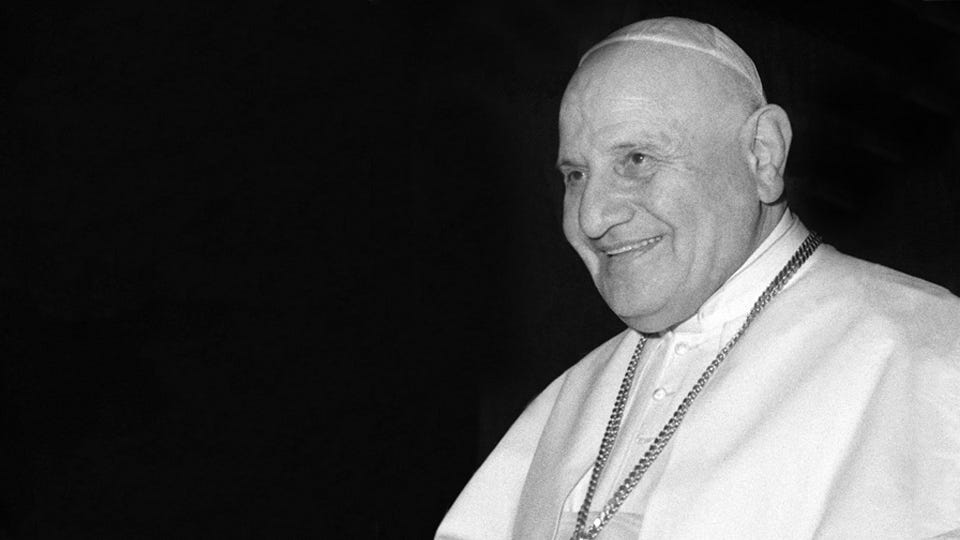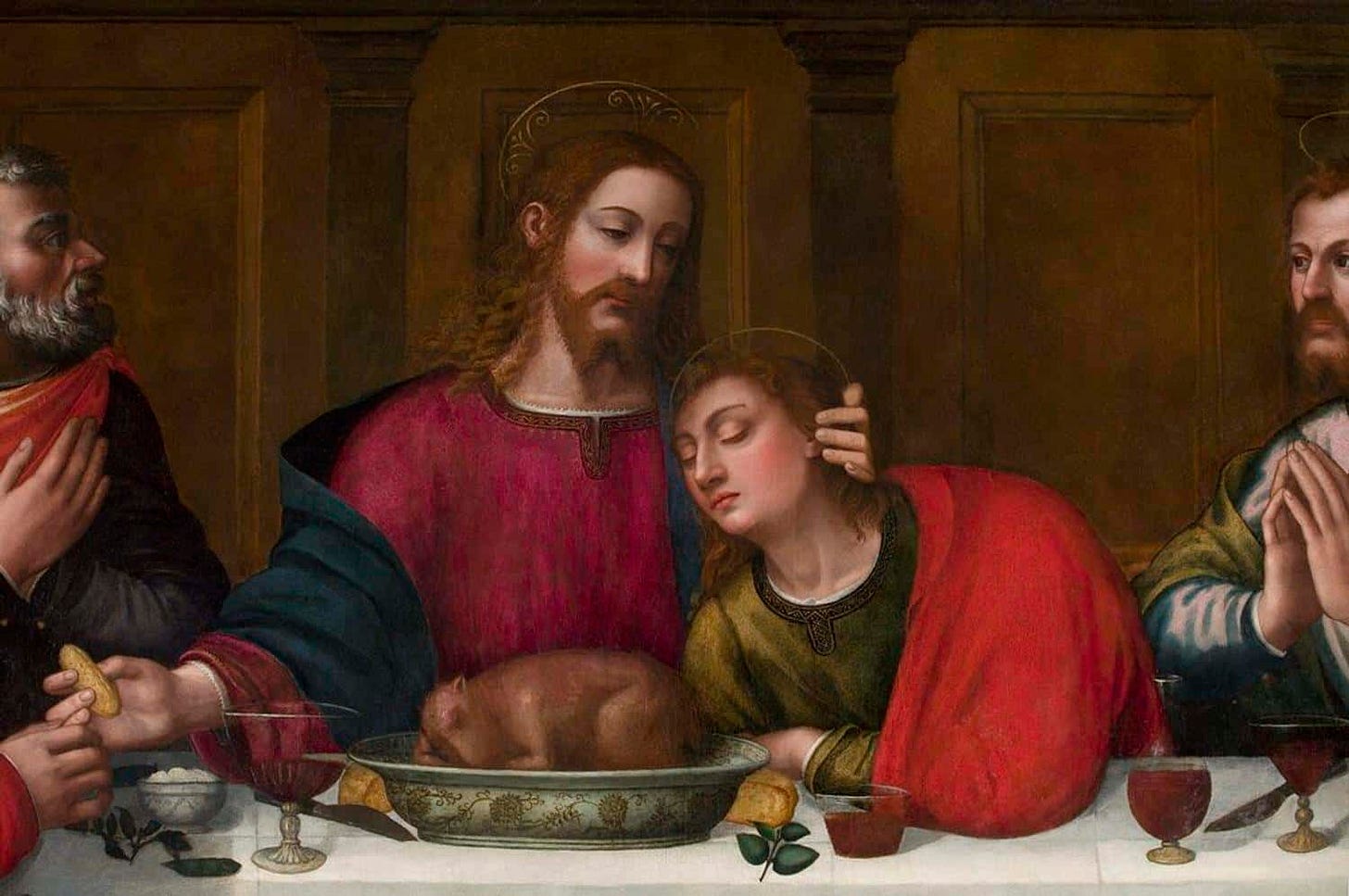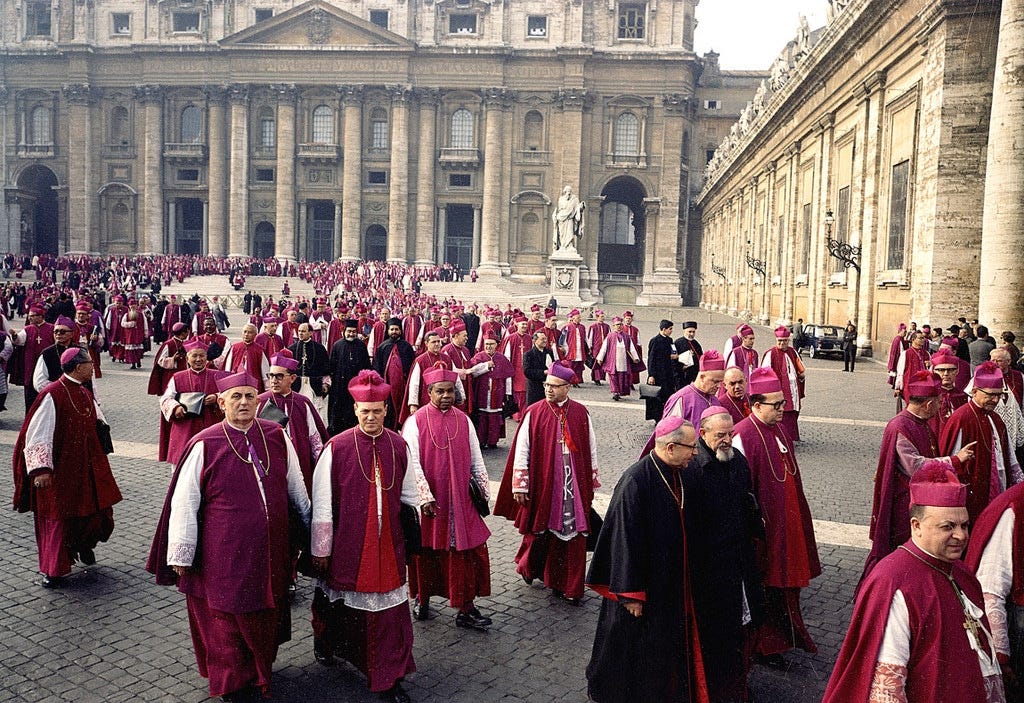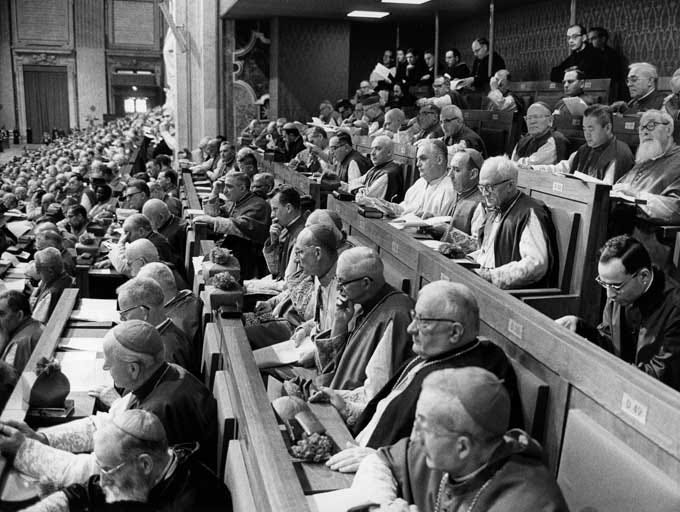(This is the third installment of my series on the history and reception of the Second Vatican Council, in response to
. You can find the first two here: Introduction & Part One.)In his 2004 primer, Still Interpreting Vatican II, Australian theologian Ormond Rush offers three hermeneutical principles for making sense of the Council:
A hermeneutics of the authors.
A hermeneutics of the texts.
A hermeneutics of the receivers.
In this post we’ll focus on the first of these: the hermeneutics of the authors. Who were the human agents at work in Vatican II? How did they understand their task? What did they think they were accomplishing through it? As I wrote last time, Vatican II was an event, and a complex one at that. We can’t reduce it to its documents alone. Or rather, we can’t fully understand those documents without a grasp of the people who created them. The texts of the Council were born of compromise. While the vast majority of bishops, as we’ll see, wanted bold changes, a recalcitrant minority sought to blunt their progress at every turn.
The majority had the raw numbers to defeat these traditionalists in floor votes, but some leaders—especially Pope Paul VI—feared that schism would result. Thus the majority constantly made concessions to the minority when it came to writing the documents in order to achieve near unanimity. The result was often schizoid: passages that broke new ground and advanced the cause of the majority were immediately followed by ones that put the brakes on.
This internal tension and even contradiction is obvious to casual readers, leaving many confused about what the Council ultimately wanted. Only by understanding the authors, then (read in context against their historical backdrop) can we discern the direction they were taking the church—the “Spirit of Vatican II.” There are many such characters to consider, but today I wish to spotlight one in particular, the man who brought the Council into being: Pope John XXIII. He isn’t the only figure whose intentions matter, hardly. But he was indispensable in calling the meeting, identifying its goals, and setting the tone.
I. Divine Inspiration
Standing before you, I tremble somewhat with emotion but am humbly resolute in my purpose to proclaim a twofold celebration: a diocesan synod for the city of Rome, and a general Council for the universal Church!1
When the pope uttered these words on January 25, 1959, it came as a complete shock. He was speaking to a small group of cardinals at the basilica of St. Paul’s Outside the Walls in Rome, where they’d gathered to conclude the week of prayer for Christian unity. The man behind the papal title, Angelo Roncalli, had been elected three months prior as what everyone assumed would be a care-taker pontiff. No one in the hierarchy expected—and even less desired—that he, at 78, would make drastic changes. If they’d read their Bible closely, though, they would’ve remembered that God works his greatest wonders through the unlikeliest of ambassadors.
And in this case, it literally was an ambassador. Roncalli was born in 1881 to peasants at Sotto il Monte, a tiny village near Bergamo in northern Italy. The fourth of thirteen children, he remained devoted to his family throughout his life, holding onto their simple piety as his North Star. He received a traditional theological formation in seminary and was ordained a priest in 1904. Afterwards, he spent a decade teaching church history and Patristics in Bergamo.
During the Great War, he served in the Italian army, first as a medical worker and then chaplain. Pius XI made him bishop a few years later and sent him as an apostalic delegate to Bulgaria from 1925 to 1934. From 1935 to 1944 he held the same position in Istanbul for Greece and Turkey. In 1944, Pius XII named him nuncio to Paris, the Vatican’s most prestigious diplomatic post, in the immediate aftermath of the city’s liberation from the Nazis. There he distinguished himself by diffusing tensions between de Gaulle’s government and the French episcopate, several of whose members had compromised themselves with the puppet regime at Vichy. He left Paris in 1953 when the pope dubbed him patriarch of Venice. John O’Malley highlights the lessons Roncalli took from his peripatetic journey:
His career as a priest carried him to situations and places that gave him a breadth of experience none of his predecessors had.
Even John’s humble origins were unusual; the popes of the 19th century came from noble, aristocratic, or well-placed families. His decade as a teacher and twenty years as a diplomat in Eastern Europe gave him a historical and personal perspective on the church that wasn’t centered on Rome. Catholics, moreover, were a tiny minority in those countries, and those that did exist were of the Eastern churches. Orthodox Christians and Muslims dominated the populace. This wider, Eastern, multi-faith reality—peripheral to his peers—would play a crucial role at the Council.
As a person, the new pope was direct and free-spirited. His warmth, humor, and grandfatherly quality endeared him to the world from the moment of his election. “He smiled, told jokes, was spontaneous in manner and unconcernedly fat,” O’Malley says. He readily expressed love for his family, and evinced a felt knowledge of God's presence in his life (the depths of which were revealed with the posthumous publication of his journal). Coming on the heels of his severe predecessors, this vulnerable, compassionate, embodied humanity “seemed to be the living image of what [people] believed or hoped to church to be.” These very traits, however, engendered disdain on the part of some in the Curia, who misread him as a naif. Hence their stupefied reaction to his call for a council.2
It wasn’t just his personality, though, that made the announcement turn heads. After papal infallibility was promulgated by Vatican I (1869-70), some speculated that councils were obsolete, since the pope himself could solve all problems. And unlike the previous twenty councils, no immediate crisis confronted Catholicism—at least as far as the Curia was concerned. All heresies had been routed in the preceding decades. What more needed doing? A secret plan had developed in the 1940s to convene a council to condemn Modernism (again); another to enhance the authority of the pope even when he wasn’t speaking “infallibly;” and a third to bolster the church’s teaching on Mary. But Pius XII did all these things, in the end, by himself. The papacy, backed by its army of bureaucrats, was much more efficient (and predictable) than councils. The latter were unwieldy and prone to surprises. And the Curia wanted no surprises.
But the Spirit blows where it wills. The idea for an ecclesial convocation came to John spontaneously just ten days earlier, while strolling the papal grounds with Cardinal Domenico Tardini, his Secretary of State. Tardini responded with enthusiasm, and John moved fast. His proclamation caught the Curia completely off guard. A few days before, a secretary to a cardinal informed him that the pope would be going to St. Paul’s and had asked the cardinals to attend because John had something big to reveal. The cardinal spurned the request:
What sort of important thing could he say on such an occasion? He will give an exhortation to the monks, nothing more.
II. What John Wanted
If the announcement of a council itself triggered apoplexy in some circles, so, too, did John’s wording. By calling for a synod for Rome before declaring a universal council, John acknowledged his primary role to be bishop of a local diocese, not the head of the universal church. Such language recalled the ancient (and Eastern) view of the pope as first among equals, and signaled his opening salvo against the triumphalist ideology of his predecessors. It was an ideology that Vatican prelates guarded fiercely.
What, then, were John’s aims for the Council? He spelled out several in his opening announcement and in the weeks following:
To promote the “enlightenment, edification, and joy of the entire Christian people.”
To extend “a renewed cordial invitation to the faithful of the separated communities to participate with us in this quest for unity and grace, for which so many souls long in all parts of the world.”
To increase Christians’ commitment to their faith, “to make more room for charity…with clarity of thought and greatness of heart.”
Each of these deserves attention, because they aren’t usually the topics that roll off the tongue of today’s Vatican II analysts. The first was the enlightenment, edification, and joy of the entire Christian people. This language, too, was gobsmacking to its first listeners. As you read in my last post, the rhetoric emanating from Rome over the previous century had been caustic, fearful, and threatening. But here John mused in warm tones of improving his flock’s theological knowledge—a subtle nod to Luther and the Reformers’ emphasis on religious literacy and personal spirituality. Moreover, he spoke of joy—joy! He was reminding people (i.e., his fellow bishops) that being a Christian should make them fully alive, not gloomy, severe, or dour. And he wished this joy, moreover, for the entire Church of Christ, not just Catholics. The pope had never struck such an irenic posture.
Which leads us to the second of John’s goals: Christian unity. This was an even greater thunderbolt. Just thirty years prior, Pius XI had condemned the ecumenical movement and barred Catholics from worshipping alongside Protestants and Anglicans. Pius XII had reaffirmed this stance in 1950. Now, the pope himself was extending a hand of friendship. What’s more was how he couched the invitation. Gone was the order for “dissidents” to “return” to the one, true church. Instead, he spoke of other Christians as “the faithful of the separated communities” and asked them to journey with Rome in a joint search not only for unity, but grace, too.
In other words, he was hinting that the path to healing the Body of Christ lay not in “heretics” coming back to Rome, sweet home (as if Catholicism hadn’t itself been created by the Reformation). Rather, it would mean recognizing that each denomination had treasures to be valued and shared, denied the others by the messy divorce of the 16th and 17th centuries. Unity would be found not by refighting the battles of long ago, but by walking together into an undetermined communion of the future. Giuseppe Alberigo sums up the effect:
That the pope should be the one to take the initiative for unity among the churches and to outline the process in terms of cooperation toward creating “a single flock,” and no longer in terms of returning to the past, was unexpected almost to the point of being unbelievable.3
Finally, John wished for love. There’s a deep irony here that’s lost on today’s critics of the Council: its fundamental goal was to make Christians more charitable, with “clarity of thought…and greatness of heart,” as the pontiff put it. The primary measure of the Council’s success, then, is whether it leads to greater compassion on the part of Catholics. That’s not something captured by numbers of butts in the pews or marriages in the church or infants baptized (which, as I’ve written, we shouldn’t do anyway). But it can be felt through the tenor and tone of the church’s leaders and most prominent voices. Its absence from those circles in recent decades might just, then, be a sign that the church is failing the Council, not the Council the church.
If these statements weren’t explosive enough, the pope also spoke publicly of “bringing the pontificate into clear and definite correspondence with the spiritual needs of the present day” and a “new Pentecost,” in which the Holy Spirit would pour out its “wonders in our own age.” This sent chills down the spines of curial officials. How did the papacy need to be “updated?” What did that even mean? And what goods could be found in the present age that the pope could possibly be out of step with? Didn’t the church have the full deposit of revelation and all the tools necessary for salvation? Grace flowed from the God to the world through Rome, not the other way around.
What really sent his courtiers into fits of pique, though, was when John said the time had come “to specify and distinguish between what belongs to the realm of sacred principles and the perennial gospel, and what changes with the passing of time.”4 This was offensive to pious ears. It smacked of the dread historicity, the notion that Catholicism had developed. The church wasn't some eternal rock standing athwart the chaos of time. Moreover, John implied a gap between the gift the church had been given—the Gospel—and the way it shared that gift. His core insight was that the person of Jesus—in all his charisma, dynamism, and attractiveness—was being occluded by layers of institutional barnacles. The Incarnate Word could no longer be heard above the din of pharisaical churchmen. The pope’s statement called to mind the old saying:
In necessary things unity; in uncertain things liberty; in all things charity.
But if the Curia stood aghast, elation filled the hearts of everyone else. A feeling of ecstatic relief burst among the faithful, among people the world over, in fact. The straight jacket of thought and behavior that Rome had kept everyone in for centuries was loosening. Life was returning. John wanted the Council to put an end to the post-Tridentine era, even to the Constantinian epoch and its imperial church. In its place, a new age was to be ushered in, marked by a restored Christian witness and proclamation of the Good News. Alberigo captures the sea change aptly:
Previously known as an element of continuity and identity for Western society, the Roman papacy began to provide an impulse toward change and renewal, even of society itself.5
III. Preparing the Council
Amidst this euphoria, the Holy Office was beset by agitation, baffled that a pope could suddenly announce a council without first consulting them. But if the Curia was taken by surprise, it quickly woke up. To prevent ruin, they had to head the Council off at the outset and kneecap its authority. Their first move was to request that the head of each conciliar commission be the prefect of its corresponding Vatican department. This would afford them tight control on the proceedings and entire structure of the Council. They’d already achieved such a hold on the Pre-Preparatory Commission, in fact, whose membership was monopolized by Roman officials. John, however, pushed back, instructing that the secretaries of the commissions be selected from outside the Vatican.
The Curia also tried to determine the conciliar questions in advance, knowing that agenda-setting is where real power rests. Its officials insisted on sending a detailed questionnaire to bishops and theologians, soliciting feedback only on the questions posed. Again, John rejected this idea, saying that the attendees were to be asked themselves what should be debated. He also made clear that this would be a new council, not a continuation of the unfinished Vatican I. Finally, he entrusted the preparatory phase to the Secretariat of State under Tardini, not Ottaviani and the feared Holy Office. These moves, which isolated the pope from the Curia going forward, revealed that he didn’t want the Council prepared in the usual dogmatic manner. They also gave crucial breathing room to reformers. Without them, the Council would’ve been smothered in its crib.
On June 18, 1959, a letter went out from the Pre-Preparatory Commission to 2,598 prelates, inviting their responses in “complete freedom and honesty.” The bishops were stunned by the offer to assume an active role in church governance. After years of being dictated to, many doubted the sincerity of the offer, and took time to grow into their new authority. Theologians, too, were skeptical at first. Almost all of them had been scrutinized, persecuted, or outright silenced by Rome in recent years. Now they were being brought in from the cold to shape the most seminal ecclesial event in half a millennium? Like the disciples at Easter, they were incredulous.
The bishops’ replies poured into Rome in the ensuing weeks, eventually topping 5,000 pages. Combined with responses from Vatican congregations, universities, and Catholic institutions the world over, the paper swelled to twelve large volumes. The Pre-Preparatory Commission sorted through this staggering amount of material over a period of five months, synthesizing it into fifty-four topics in eleven categories. These were then assigned to ten Preparatory Commissions, staffed by 854 clerics ranging from priests to cardinals. They worked tirelessly for two years, until February 2, 1962, to produce documents to be submitted to the convocation.
Despite the pope’s efforts, the preparatory phase did allow the Curia to control the initial agenda. Many issues that the bishops brought up in their responses weren’t sent to the commissions, in fact, because the Pre-Preparatory Commission decided they lacked merit. To be fair, the bishops’ responses were generally timid and devoid of value. After centuries of centralization, they were at this point wedded to the pre-conciliar mentality of obedience and rigid thinking. In any case, by the end of the preparations, the Curia believed they’d accomplished most of the Council’s heavy lifting. They guarded their draft documents jealously, reluctant to admit the possibility of radical revisions. Vatican II, they smiled, would be a rubber stamp.
The end result of all this was that while many topics presented themselves, no clear vision or overarching conceptual framework emerged during the Council’s buildup. Nevertheless, three broad themes stood out:
Christian Unity. Despite the pope’s initial remarks, the Council would not be dedicated explicitly to uniting the various Christian denominations. But ecumenism would make for a major topic, and John insisted that the Catholic Church signal a fresh attitude toward outsiders and willingness to join the work for unity.
Pastoral Approach. John also repeatedly called for a new pastoral style, eschewing the tradition of pairing doctrine and discipline, faith and morals. The church “desires to show herself to be the loving mother of all,” he said. We’ll have a lot to unpack about this approach in our final analysis, but in general it was marked by an evangelical attitude based on solidarity with all and a desire that the church reflect Christ, the Good Shepherd, in every act.
The Authority of the Bishops. Finally, John—despite the disbelief on the part of his brothers—emphasized the bishops’ autonomy in leading the Council. This restored episcopal collegiality, and its relationship to the papacy, would itself become the major conflict at Vatican II, the issue to end all issues. It’s still an unresolved question, in fact, hanging over the church with weighty implications. In many ways, today’s fights over the Council are really proxy wars for this underlying conflict, which eventually must come to a head. That’s why there’s so much at stake in interpreting Vatican II and its intent. “Who controls the past controls the future,” Orwell writes. “Who controls the present controls the past.”
One month before the start of the Council, on September 11, 1962, John issued a radio message to the world. The convocation had come “at one of the historic moments for the Church,” he said, “in which it is ready to make a new leap toward the loftiest heights.” He went on to describe his fervent hopes for what the Council would be:
A renewed face-to-face encounter with the risen Christ, the glorious and immortal king, and a continuation, or better, a more energetic revival of the response of the entire modern world to the word of the Lord.
Finally, the pope spoke in tender terms of his desire that the church present itself as “the Church of all, and particularly of the poor.” The son of peasant farmers, now the Supreme Pontiff, John wished his flock to follow the carpenter from Nazareth with renewed humility, simplicity, and gentleness of heart. That, more than anything, was what he wanted from Vatican II.
Giuseppe Alberigo, A Brief History of Vatican II (Orbis: New York, 2006), 1.
John O’Malley, What Happened at Vatican II (Cambridge: Harvard UP, 2008), 103-105.
Alberigo, 7.
Alberigo, 2.
Alberigo, 4.









